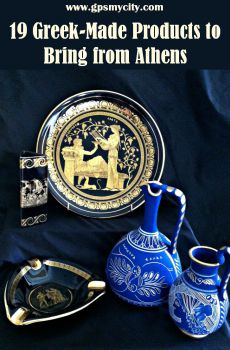Kerameikos Ancient Cemetery, Athens
If ancient Athens had a VIP section for the dearly departed, Kerameikos would be it. Now, before you start picturing some dusty ruins with a few sad stones, let’s set the record straight-this place is an oasis. Really. Thanks to the lush Iridhanós stream decorated with water lilies, which lazily meanders through the site, it makes it feel more like a secret garden than a burial ground.
As you enter, glance to your right. There’s the impressive double line of the city wall. Ancient Athens wasn’t an open-door policy kind of town-two major roads once sliced through these defenses, each with its own grand gate-now unearthed through excavations.
First up, the Dipylon Gate, the city’s busiest entrance in its heyday. If ancient Athenians had morning traffic, this is where it all happened-the hustle and bustle of traders, travelers, and festival-goers pouring in from Piraeus, Eleusis, and the north. Then, there’s the Sacred Gate, which wasn’t just a fancy name-it had a VIP role, welcoming the famous Eleusinian and Panathenaic processions into the city, which were basically parades of the gods.
Wander left from the Sacred Way, and you’ll find the Street of the Tombs, where Classical Athens put its best funerary art on display. Expect a mix of solemn ancient headstones and sarcophagi from later Hellenistic and Roman times. Among the highlights is The Memorial of Dexileos, honoring a 20-year-old warrior who fell in battle in 394 BC, and the Monument of Dionysios of Kollytos, topped with a striking, exquisitely sculpted Pentelic marble bull-why settle for a regular tombstone when you can have a full-on animal guardian?
Now, if you love artifacts, the Kerameikos Museum is a must. A chic, marble-floored gallery showcasing stunning ceramics, intricate grave markers, and even children’s burial toys (poignant, yet fascinating). The pottery collection is particularly dazzling, with everything from horse-adorned dishes from the 8th century BC to those famous black-and-red figure vases of the 5th century BC.
Tip:
Your ticket to Kerameikos is part of the Acropolis multi-site pass, so don’t let it go to waste! And before you leave, climb the hill near the entrance-there’s a charming little church and a sweeping panorama of the entire site, perfect for a quiet moment of contemplation… or a dramatic selfie.
As you enter, glance to your right. There’s the impressive double line of the city wall. Ancient Athens wasn’t an open-door policy kind of town-two major roads once sliced through these defenses, each with its own grand gate-now unearthed through excavations.
First up, the Dipylon Gate, the city’s busiest entrance in its heyday. If ancient Athenians had morning traffic, this is where it all happened-the hustle and bustle of traders, travelers, and festival-goers pouring in from Piraeus, Eleusis, and the north. Then, there’s the Sacred Gate, which wasn’t just a fancy name-it had a VIP role, welcoming the famous Eleusinian and Panathenaic processions into the city, which were basically parades of the gods.
Wander left from the Sacred Way, and you’ll find the Street of the Tombs, where Classical Athens put its best funerary art on display. Expect a mix of solemn ancient headstones and sarcophagi from later Hellenistic and Roman times. Among the highlights is The Memorial of Dexileos, honoring a 20-year-old warrior who fell in battle in 394 BC, and the Monument of Dionysios of Kollytos, topped with a striking, exquisitely sculpted Pentelic marble bull-why settle for a regular tombstone when you can have a full-on animal guardian?
Now, if you love artifacts, the Kerameikos Museum is a must. A chic, marble-floored gallery showcasing stunning ceramics, intricate grave markers, and even children’s burial toys (poignant, yet fascinating). The pottery collection is particularly dazzling, with everything from horse-adorned dishes from the 8th century BC to those famous black-and-red figure vases of the 5th century BC.
Tip:
Your ticket to Kerameikos is part of the Acropolis multi-site pass, so don’t let it go to waste! And before you leave, climb the hill near the entrance-there’s a charming little church and a sweeping panorama of the entire site, perfect for a quiet moment of contemplation… or a dramatic selfie.
Want to visit this sight? Check out these Self-Guided Walking Tours in Athens. Alternatively, you can download the mobile app "GPSmyCity: Walks in 1K+ Cities" from Apple App Store or Google Play Store. The app turns your mobile device to a personal tour guide and it works offline, so no data plan is needed when traveling abroad.
Kerameikos Ancient Cemetery on Map
Sight Name: Kerameikos Ancient Cemetery
Sight Location: Athens, Greece (See walking tours in Athens)
Sight Type: Attraction/Landmark
Guide(s) Containing This Sight:
Sight Location: Athens, Greece (See walking tours in Athens)
Sight Type: Attraction/Landmark
Guide(s) Containing This Sight:
Walking Tours in Athens, Greece
Create Your Own Walk in Athens
Creating your own self-guided walk in Athens is easy and fun. Choose the city attractions that you want to see and a walk route map will be created just for you. You can even set your hotel as the start point of the walk.
Athens Introduction Walking Tour
Athens, the cradle of Western Civilization and one of Europe's oldest cities, originated between the 4th and the 3rd millennia BC. The story of Athens stems from a mythological contest between the goddess of wisdom and warfare, Athena, and the god of the sea, Poseidon. Both deities vied to become the city's patron. Poseidon's gift of a saltwater spring was deemed impractical,... view more
Tour Duration: 3 Hour(s)
Travel Distance: 4.2 Km or 2.6 Miles
Tour Duration: 3 Hour(s)
Travel Distance: 4.2 Km or 2.6 Miles
Athens Food Walking Tour
Traditional Greek cuisine is one of the healthiest in the world, and prices in all but the flashiest establishments afford excellent value. The prevalence of vegetable and dairy dishes makes eating out a delight for non-meat eaters. Carefully selected appetizers (tzatzíki, dolmádes, kalamarákia) can constitute a full meal. Greece’s most famous slow-cooked oven dish, however, is probably... view more
Tour Duration: 1 Hour(s)
Travel Distance: 2.2 Km or 1.4 Miles
Tour Duration: 1 Hour(s)
Travel Distance: 2.2 Km or 1.4 Miles
Plaka Attractions Walking Tour
Plaka, the oldest-and in many views, the most photogenic-district of Athens is where history isn’t just studied, it’s lived. Nestled at the foot of the mighty Acropolis, this is the "neighborhood of the Gods"-which sounds dramatic, but when you see it, you’ll understand why.
People have settled here since antiquity, so don’t be surprised if the walls seem to whisper ancient... view more
Tour Duration: 2 Hour(s)
Travel Distance: 3.6 Km or 2.2 Miles
People have settled here since antiquity, so don’t be surprised if the walls seem to whisper ancient... view more
Tour Duration: 2 Hour(s)
Travel Distance: 3.6 Km or 2.2 Miles
Walking Tour Around the Legendary Acropolis
Ah, the Acropolis of Athens-also known as "the sacred rock," because apparently, even rocks can have VIP status. This iconic hill has been home to temples, sanctuaries, and centuries of drama (both the theatrical and the historical kind). The ancient Greeks held this place in such high regard that they built architectural marvels that still dominate the city’s skyline. You can spot the... view more
Tour Duration: 1 Hour(s)
Travel Distance: 1.0 Km or 0.6 Miles
Tour Duration: 1 Hour(s)
Travel Distance: 1.0 Km or 0.6 Miles
Walking Around the National Garden
The National Garden is an impressive, historic park in the center of Athens, complete with artificial streams and duck ponds. Formerly known as the Royal Garden, it was commissioned by King Otto’s queen, Amalia, in 1838, reason why it is located directly behind the Old Palace (currently the Greek Parliament building). Not only is it a welcome refuge from the swirl of traffic just outside the... view more
Tour Duration: 2 Hour(s)
Travel Distance: 3.3 Km or 2.1 Miles
Tour Duration: 2 Hour(s)
Travel Distance: 3.3 Km or 2.1 Miles
Useful Travel Guides for Planning Your Trip
Souvenirs Shopping: 19 Uniquely Greek Products to Bring from Athens
A cradle of European civilization, Greece, in general, and Athens, in particular, have long been - from the days of the Roman Empire up until present - the lure for travelers and history buffs seeking to find and bring home something memorable. Today's Athens (much as its ancient self) offers a...
14 Best Cafes in Athens
While in Athens it is immediately noticeable that the local cafe culture thriving. Through this directory you will get a chance to visit very different establishments, ranging from "kafenia", to hip, modern coffee shops and get first hand experience of the diversity of contemporary Greek...
A Self-Guided Food Walk in Athens
Just as many things in Greece, dining in Athens is very much laid-back with the majority of local eateries seeing patrons begin to congregate for dinner only after 8 pm. Eating-wise, the Athenians favor simplicity, leaning to the more casual and not so pricey tavernas where food is plentiful. To...











